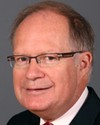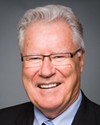Thank you, Mr. Chair.
To begin with, I would like to thank all the members of the committee for inviting me here this afternoon to present a summary of the lecture that was given at the “Bacon and Eggheads Breakfast” at the beginning of May. I am very pleased to be here.
Given the time constraints this afternoon, I won't have time to present the full bacon and eggheads presentation that I presented at the start of May in the West Block. Rather, we'll focus on just a few key points that I hope will illustrate the importance and value of the new geological map of the Arctic for Canada and Canadians.
To start with, then, the new geological map of the Arctic, of which we have copies in the back for anyone interested in obtaining one, was published by the Geological Survey of Canada, part of the earth sciences sector of Natural Resources Canada, with the map presently available either as a hard-copy paper product for purchase or as a free download from the Natural Resources Canada government website.
Development of the new geological map of the Arctic was led by a Canadian research team based in Ottawa and Calgary, with the active and enthusiastic participation of scientists and technical staff from the geological surveys of Russia, the U.S., Norway, Denmark, Sweden, and Finland. Work on this project began in February 2006. The map was released to the public in November 2008.
If I could ask you to turn to page 30 of the handout, you'll see that the reason the new geological map of the Arctic and the related underlying database is so noteworthy is that the two together provide, for the first time, a complete, seamless, internally consistent digital documentation and interpretation of the circumpolar geology, with the map documenting, along with the related database, the distribution, the age, the composition, the association, the environment of formation, and the state of preservation of no less than 1,222 major map or rock units in the circumpolar Arctic. In other words, by combining various colours, various patterns, and various alphanumeric codes for different rock units or map units, this map provides information on those units all the way around the Pole, for all onshore areas and all offshore areas, with no gap, no break. In addition to all of this, the map also documents the location of linear and point features such as active faults or ancient faults, active volcanoes or dormant volcanoes, and other features that are listed on page 30.
In addition to documenting what is where from a geological point of view in the circumpolar Arctic, what else do this map and database do for us? If we turn to page 31, we see that the map and database, importantly, provide a global context for known mineral resources. In other words, a map user can go to the map and can go to the database, query about the geological context for a known mineral resource outside of Canada, and bring that information back to Canada in order to evaluate whether or not a similar geological context for similar mineral deposits might not be found in Canada.
Let's just look at one example. On page 31, again, we see zinc-lead deposits in central northern Norway, well known, with their characteristics written out on page 31. The question would be, is there a chance that similar deposits might be found in northern Canada? If we turn to page 32, we see that the answer is yes, and the similar yet unexplored geological context for that type of deposit corresponds to Bathurst Island, an island in the centre of the Canadian Arctic Archipelago. So that's just one example, with one commodity, of how information about known deposits elsewhere can be brought back to Canada to guide exploration in Canada.
The deck provides a similar example on the energy side of things, specifically natural gas, given that the new geological map of the Arctic and related database also provide a global context for any energy resources in the circumpolar Arctic. But I'll leave that for you to read, and I'll just address one last point in my presentation, and that is how the new geological map of the Arctic and related database can help constrain the geological origin of any given onshore or offshore feature. I thought for the presentation this afternoon that I'd use the example of the Lomonosov Ridge, thinking that might be of interest to some of you.
If you turn to page 36 of the deck, then, what you have there is the current plate tectonic geometry or configuration for the polar regions. There are three large tectonic plates: the Eurasian Plate, which carries northern Europe, western Russia, and central Russia; the North American Plate, which carries northern Canada, Alaska, and easternmost Russia; and the Greenlandic Plate, which carries Greenland.
The feature of interest, the Lomonosov Ridge, is highlighted with the dark blue line, separated from the Eurasian continent to the northeast by the Eurasian Basin, in much the same way as Greenland is separated from Norway and northern Europe by the North Atlantic. The present plate tectonic motions are shown with the red arrows, with the North American Plate and the Greenlandic Plate moving away from the Eurasian Plate at a rate of 1.4 to 2 centimetres every year. And you wonder why transatlantic travel costs more every year.
The way to constrain the geological origin of the Lomonosov Ridge, then, is to simply reverse the motion of the plates digitally and go back far enough in time, in a number of bite-size time increments. Looking at page 37, it is one step back in time to 23 million years ago. You will note that the North Atlantic is much narrower, Iceland has disappeared, the Eurasian Basin is narrower, and because of that, the Lomonosov Ridge has moved incrementally towards the Eurasian continent.
Turning to page 38, stepping back in time to 34 million years ago, the North Atlantic is much narrower again, the Eurasian Basin is narrower, and the Lomonosov Ridge is that much closer to the Eurasian continent.
On page 39, stepping back to 56 million years ago, the North Atlantic and Eurasian Basin are both much narrower, and this time Davis Strait, the body of water separating Greenland from northeastern Canada, is also starting to close, with Greenland moving back towards Canada.
And in a final step back in time, on page 40, to 61 million years ago, the North Atlantic is fully closed, the Eurasian Basin is fully closed, Davis Strait is fully closed, and the three tectonic plates—the Eurasian Plate, the North American Plate, and the Greenlandic Plate—are forming one large composite polar plate, with the Lomonosov Ridge tucked back, parked against the western rim of the Barents Sea continental shelf or European continental shelf, from whence it came.
In other words, the geological origin of the Lomonosov Ridge is as the outermost edge rim piece of the European continental shelf, faulted off, ripped off 61 million years ago.
The take-home message is that this was 61 million years ago. Ever since then, for a period of time that's longer than the Himalayas have been forming in Southeast Asia, the Lomonosov Ridge has been part of the North American Plate, moving away from northern Europe, moving away from western Russian, in tandem with the Canadian land mass at a rate of 1.4 to 2 centimetres a year, tracking 900 kilometres west to where we now find it beneath the North Pole.
The implications for Canada of having produced and published the geological map of the Arctic and related database are listed on pages 41 and 42. I could go through that or let you read it. I think possibly I'm out of time. I will conclude my comments with that.
Thank you very much, Mr. Chair.
Thank you very much for your attention.











